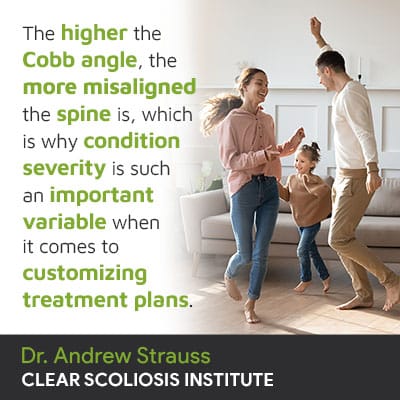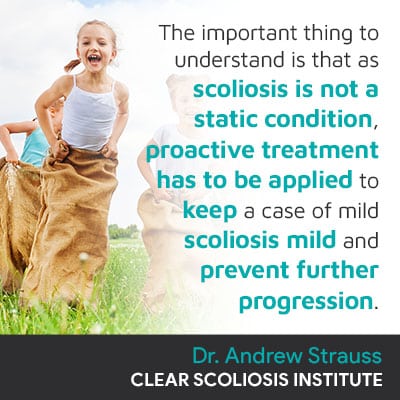
When scoliosis is diagnosed, part of the process involves further classifying aspects of the scoliosis based on important patient and condition variables. Factors such as patient age at diagnosis, condition type (cause), curvature location, and curve size help shape the design of effective treatment plans. Continue reading to learn how conditions are classified as mild, moderate, or severe.
Scoliosis can range from mild to severe, and condition severity is determined by a measurement known as Cobb angle. A Cobb angle of between 10 and 25 degrees is classified as mild scoliosis, and there are two main treatment approaches to choose between.
Before getting to the specifics of mild-scoliosis treatment, let’s first explore how condition severity is determined.
There are a number of factors that make scoliosis a complex condition to treat; not only are there different condition types with unique causes and treatment needs, there are also multiple curvature types, patterns, and severity levels ranging from mild to severe.
Part of being diagnosed with scoliosis involves comprehensive assessment to further classify conditions based on important patient/condition variables.
Not only does classifying conditions help streamline the treatment process, it also helps shape the design of effective treatment plans; condition severity is a key variable and is determined by a measurement known as Cobb angle.
A patient’s Cobb angle is measured during X-ray and involves drawing lines from the tops and bottoms of the most-tilted vertebrae at the apex of the curve, and the intersecting lines form an angle that’s expressed in degrees:

For someone diagnosed with mild scoliosis, the good news is because the condition was caught while mild, there are fewer limits to what can be achieved with treatment; before we get to specific treatment options, let’s first discuss some mild scoliosis symptoms.
As mentioned, there are benefits associated with early detection, but it’s not always easy to spot the condition’s early signs, and those benefits are only available to patients undergoing proactive treatment.
While there are different types of scoliosis, the most prevalent is adolescent idiopathic scoliosis (AIS), diagnosed between the ages of 10 and 18, which is the form we’re currently focusing on.
The main symptom of scoliosis in children and adolescents is postural deviation; scoliosis introduces a lot of uneven forces to the body, disrupting its overall symmetry.
With mild AIS, early detection can be a challenge as the condition’s early signs are often subtle and difficult for an average person to notice.
In addition, mild AIS doesn’t commonly cause noticeable functional deficits, and children and adolescents don’t generally find the condition painful. Some mild pain or stiffness may be noticeable.
Prior to reaching skeletal maturity, the spine is experiencing a constant upward motion as it grows, and this can counteract the compression caused by the unnatural spinal curve; compression is the main source of condition-related pain felt not only in the spine, but also in its surrounding muscles and nerves.
In adults, as the condition becomes compressive, pain is the main symptom, making it easier to detect, but in children and adolescents, the lack of pain, functional deficits, and often subtle postural changes can make early detection a challenge.
While each case is unique, some of the earliest and most common signs of mild scoliosis in adolescents include:
In general, a disruption to the body’s overall symmetry could indicate the presence of mild scoliosis, and with uneven posture, clothing can become ill-fitting, issues with balance and/or coordination can develop, and changes to gait can also occur.
Bending forward with straight legs (Called the Adams Forward Bending Test) can accentuate curves especially in the middle back and make the scoliosis more obvious.
So what are a person’s options when it comes to treating mild scoliosis?
When it comes to treatment options, there are two main scoliosis treatment approaches to choose between, each offering patients a different potential outcome.
The two main approaches are traditional and conservative, and it's important for patients, and their families, to understand the difference because choosing which approach to commit to can have far-reaching effects.
The traditional scoliosis treatment approach can be described as more reactive than proactive; it commonly responds to a diagnosis of mild scoliosis with the recommendation to merely watch and wait for signs of further progression.
As a progressive condition, scoliosis has it in its nature to worsen over time, which is why where a scoliosis is at the time of diagnosis is not indicative of where it will stay.
Important note: The earlier the scoliosis is diagnoses, the higher the chances of progression to more severe curve size.
Just because a condition is diagnosed as mild doesn’t mean it can’t become moderate or severe, and the best way to avoid increasing condition severity is through proactive treatment.
While we don’t fully understand the underlying causes of adolescent idiopathic scoliosis (idiopathic means cause unknown), we most certainly understand what triggers its progression: growth and development.
For adolescents, the stage of puberty is marked by rapid and unpredictable growth spurts, so merely watching and waiting, and returning to a treatment provider for periodic assessments, can mean allowing a scoliotic curve to progress unimpeded.
Note: Growth of 4 inches per year is called Peak Growth Velocity!
Because watching and waiting is the main response of traditional scoliosis treatment providers, mild scoliosis can be left to progress, causing symptoms to increase, and funneling patients towards a surgical recommendation.
While spinal surgeons have their patients’ best interests at heart, spinal fusion is a costly, lengthy, and invasive procedure that carries some heavy risks and potential side effects.
While a traditional treatment approach can involve traditional bracing once in the moderate and/or severe classification, traditional braces, like the Boston brace, are associated with a number of shortfalls, and if bracing fails to stop progression, patients are in danger of progressing past the surgical-level threshold at 40+ degrees.
The issue I have with this is that had proactive treatment been applied while the condition was still mild, progression into the moderate and severe levels might have been avoided, sparing patients the hardships of increasing condition severity, escalating symptoms, and the need for more invasive treatment in the future.
A conservative treatment approach, also known as functional and/or chiropractic-centered, responds to a case of mild scoliosis very differently: with proactive treatment started as close to the time of diagnosis as possible.
As we know the condition is progressive, I don’t want to waste valuable treatment time solely watching for progression, when I could be proactively working towards either holding the patient’s curvature where it is throughout growth (counteracting the condition’s progressive nature), or reducing it further.
As a CLEAR-certified scoliosis chiropractor, I follow the CLEAR Scoliosis Institute's treatment protocols, which involves integrating a variety of condition-specific treatment modalities into a treatment plan that can be fully customized and impact conditions on multiple levels.

In addition, SSEs are known to activate certain areas of the brain for improved brain-body communication, postural remodeling, and more natural body-positioning.
Through a series of chiropractic techniques and adjustments, I can work towards adjusting the position of the most-tilted vertebrae so they are aligned with the rest of the spine, as much of the spine’s healthy curves as possible are restored, and the spine’s overall biomechanics and function are improved.
When bracing is deemed beneficial, I can select from a variety of modern corrective brace designs to augment corrective results by lifting the spine into a corrective position, thus complementing other forms of treatment.
The important thing to understand is that as scoliosis is not a static condition, proactive treatment has to be applied to keep a case of mild scoliosis mild and prevent further progression.
Mild scoliosis is diagnosed when there is an unnatural sideways spinal curve, with rotation, and a Cobb angle measurement of between 10 and 25 degrees.
As a progressive condition, the very nature of scoliosis necessitates a proactive treatment approach.
I want my mild adolescent idiopathic scoliosis patients to stay in the mild classification, despite the constant progressive trigger of growth and development throughout adolescence.
I don’t want my mild scoliosis patients to experience the hardships associated with progression, increasing condition severity, escalating symptoms, and the need for invasive surgical treatment.
When it comes time for patients to decide whether to commit to traditional or conservative scoliosis treatment, I want them to understand the difference so they can make an informed decision and ensure their treatment expectations are aligned with the reality of their potential outcomes.
When it comes to mild scoliosis, the time to start treatment is always now so patients can experience the full benefits of early detection; it’s simpler to treat scoliosis while mild, before spinal rigidity has increased alongside progression, and before the body has had ample time to adjust to its presence.

CLEAR provides a unique and innovative way of understanding scoliosis. Sign up to receive facts and information you won’t find anywhere else.
